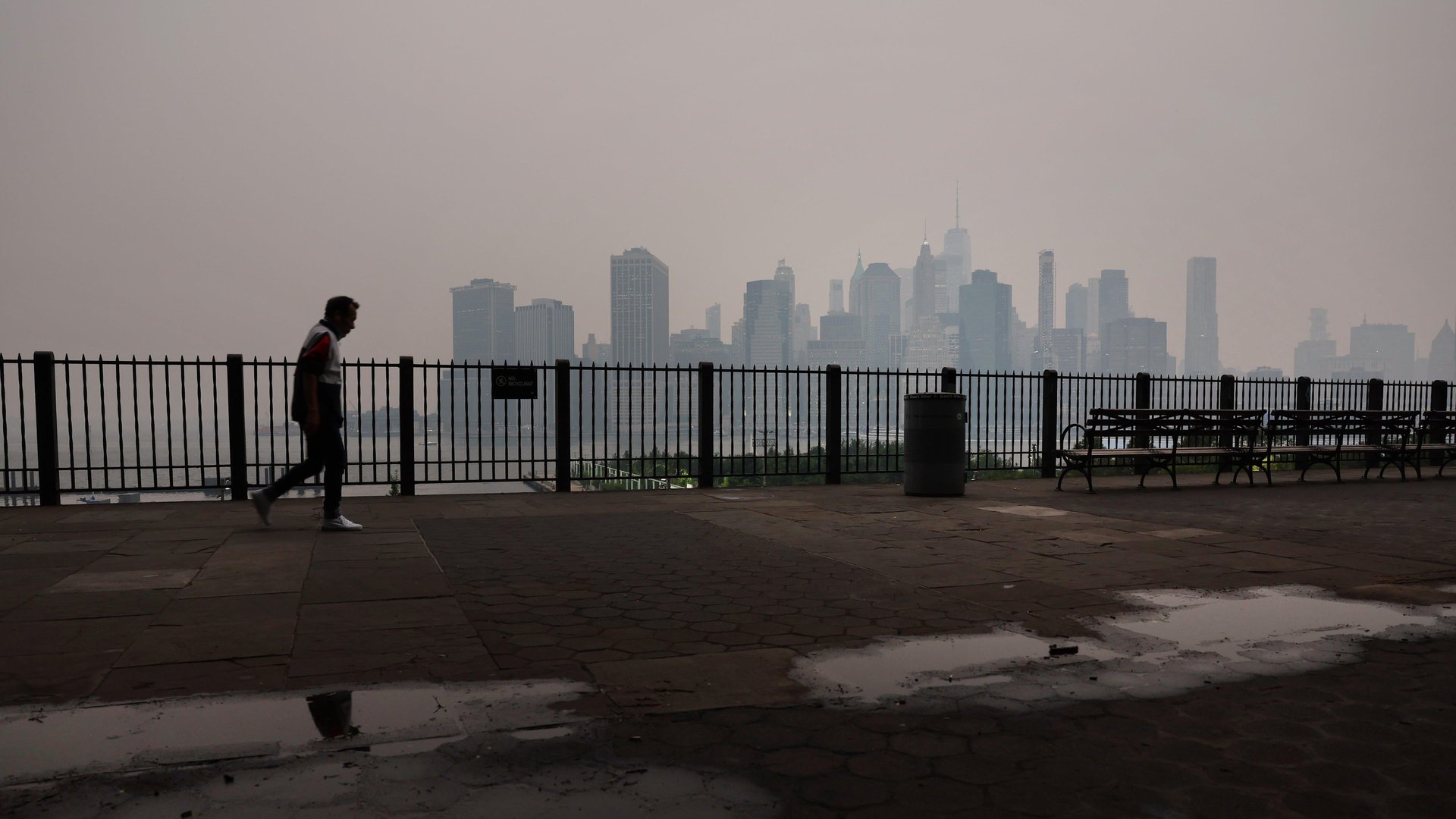Canadian wildfire smoke has given New York the worst air quality of any major city
New York City's air quality index is well above healthy levels, recalling similar polluted conditions in other major cities like Delhi and Beijing

New York City is shrouded in a smoky, apocalyptic haze, which will persist all day today (June 7).
Suggested Reading
Hundreds of wildfires in Canada have drastically worsened air quality across the northeastern US. The Big Apple’s skies have been polluted with particular matter—both particles that are visible to the eye, like dust and soot, as well as microscopic PM2.5 particles that can travel deep into the lungs and enter the bloodstream.
Related Content
Late yesterday (June 6), Mayor Eric Adams said in a news release that, by 10 pm, air quality in parts of the city had become “very unhealthy,” rising to 218 on the air quality index. The official warning for hazardous levels of “fine particulate matter” will last all day today (June 7), according to the joint air quality health advisory issued by the city’s environmental conservation and health departments. Long Island as well as central and western regions of New York state are affected too.
Residents are being discouraged from going outdoors. Schools in the metro are open, but they’re cancelling all outdoor activities. The New York Road Runners, the organization behind the New York City Marathon, suggested runners “consider running another day” instead of on Global Running Day today.
Meanwhile, Canada is poised to have its worst wildfire season on record on account of a hotter, drier summer.
Quotable: New Yorkers should stay home
“We recommend all New Yorkers limit outdoor activity to the greatest extent possible. Those with pre-existing respiratory problems, like heart or breathing problems, as well as children and older adults, may be especially sensitive and should stay indoors at this time.”
— Eric Adams, New York City’s mayor, on June 6
A recent history of New York’s air quality
2017 to 2022: New York City has not ranked in even the top 3,000 cities with the worst air quality in the recent past. Typically, the city’s score is sub-50, in the “good” category.
June 6, 2023: New York’s air quality rating of 218 ranked as the worst of any city in the world, according to the IQAir World Air Quality Index.
June 7, 2023: At the time of publishing, New York City’s air quality index reading was 170—still the worst, alongside Kuwait.
Charted: New York is choked by Canadian wildfires
Wildfires and air pollution, by the digits
418: The number of active wildfires burning in Canada at the time of publishing, according to the Canadian Interagency Forest Fire Center. More than half were burning “out of control,” the agency said.
150: The number of wildfires in Quebec, the most affected area. Local officials urged residents to shut their windows and doors.
26,000: The number of people across six provinces in Canada who were evacuated from their homes as of Monday (June 5) because of wildfires
100: The Air Quality Index (AQI) threshold for issuing an air quality advisory. At that level, the air is not conducive to sensitive people—geriatrics, children, or those who are unwell—being outdoors
17.1 times: How much higher the PM2.5 concentration—fine particles or droplets in the air that are 2.5 microns or less in width —in New York City is currently, versus the World Health Organization’s guideline value
57%: How much the risk worldwide of highly devastating fires could increase by the end of the century, primarily because of climate change, according to a landmark United Nations report compiled by more than 50 researchers from six continents
50%-80%: The amount by which a a good air filtration system can cut smoke pollution. P.S.A.: A do-it-yourself purifier can be fashioned out of a box fan, some tape, and some high efficiency filters.
A brief explanation of the wildfire pollution threat
John Balmes, a pulmonologist and professor of medicine at the University of California in San Francisco describes smoke from fires as “tobacco smoke without the nicotine.”
Short-term exposure can irritate the eyes, nose, and throat, and it can cause a range of respiratory symptoms like coughing and sneezing. Longer exposure can cause severe respiratory and heart problems. Breathing smoke can have irreversible consequences for children’s immune systems, experts warn.
If you have to step outside in wildfire smoke...
😷 Wear a high-quality N-95 mask if the AQI breaches 150
🧴 Use lotion with emollient properties—like shea butter, lanolin or petroleum jelly—to create a barrier between pollutants and your skin to avoid itchy skin and eczema.
🧥 Add another layer of protection for the skin by covering up with clothing such as full sleeves and long pants.
💧 Drink lots of water to flush toxins out of your system. Also, rinse exposed areas once you’re back indoors.